|
Limitar tu búsqueda
[+–] Compilador o editor
[+–] Editorial
[+–] Fecha
[+–] Formato
[+–] Idioma
[+–] Tipo de documento
[+–] Tipo de recurso
|

|
|
Introduction (On the issue of social capital that is addressed in this issue of the journal)
In recent decades, interest has increased in identifying, estimating and linking social capital to a variety of well-being variables in which the production of certain benefits or performance is key. Research has involved the confluence of several disciplines: economics, sociology, anthropology and psychology, to name a few. Although consensus on the definition of a single indicator for measuring...
|
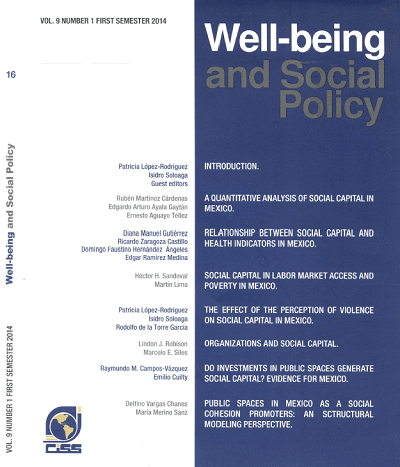
|
|
|
|

|
|
Do investments in public spaces generate social capital? Evidence for Mexico
The formation of social capital is critical for developing countries. This paper investigates the effects of attempts to recover public spaces in marginalized areas of Mexico. The effects are estimated through balancing in the propensity scores. We focus on the results of perception of safety, support and social capital. When efforts are made to recover public spaces, the perception of safety...
|

|
|
|
|

|
|
A quantitative analysis of social capital in Mexico
Se ha relacionado el capital social a la eficiencia en los mercados (Arrow, 1972), al refuerzo del contrato (Durlauf y Fafchamps, 2004) y en general al desarrollo y bienestar (Keefer y Knack 1997; Putnam 2000; Knack y Zak 2003). En el presente trabajo hemos investigado los determinantes del capital social empíricamente, centrándose en tres medidas comunes aproximadas de este: dos ligadas a la...
|

|
|
|
|

|
|
Relationship between social capital and health indicators in Mexico
This study analyzes the relationship between social capital types and access to health services in Mexico. To this end, access to healthcare data from the 2006 ENCASU and 2011 ENCAS was validated using 2006 and 2012 ENSANU results. Indicators were found to be consistent. A statistical analysis of the distribution of social capital and health indicators by region, as well as by rural or urban area...
|
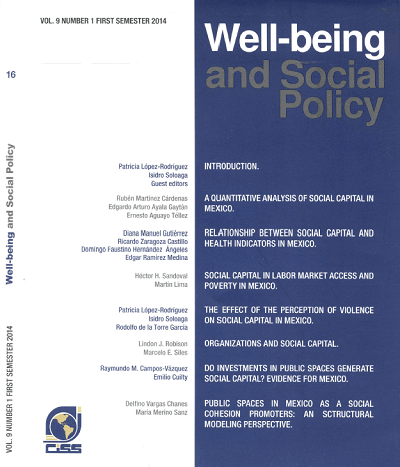
|
|
|
|

|
|
Social capital in labor market access and poverty in Mexico
Social capital, defined as the set of social networks that a person has in order to obtain benefits, is used by the population as a mechanism for providing resources, to cushion shocks in consumption and to obtain information on available employment opportunities. This study employs a logistic model to characterize the manner in which people access the labor market in Mexico through the use of...
|

|
|
|
|

|
|
The effect of the perception of violence on social capital in Mexico
Increasing levels of violence in Mexico, which have the potential to damage the very fabric of 1 society, as well as impact key economic variables, led us to analyze the effect that changes in the perception of violence had on social capital fluctuations (including associative capital) between 2006 and 2011. This was a period in which an anti-violence and anti-organized crime policy was launched...
|
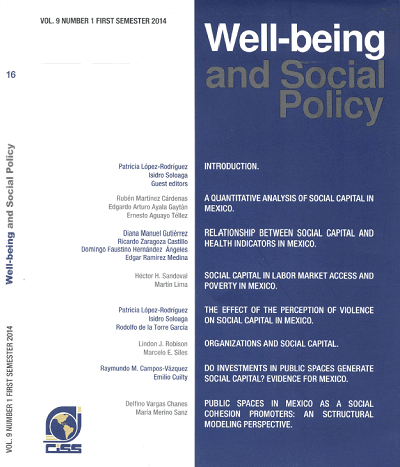
|
|
|
|

|
|
Organizations and social capital
An organization is a group of persons who satisfy established membership requirement and whose form and function are generally acknowledged. An organization's membership requirements may be based on inherited or earned traits. Organizations exist because they provide a setting in which members with similar traits can meet their physical and their socioemotional needs. As the relative importance...
|
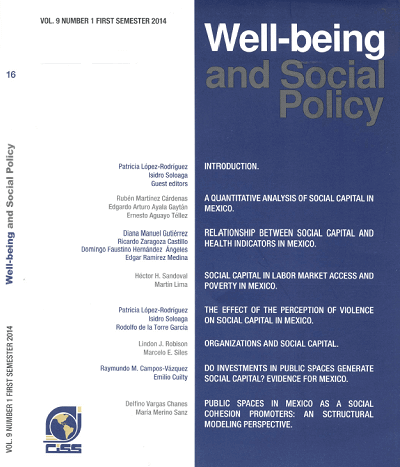
|
|
|
|

|
|
Public spaces in Mexico as social cohesion promoters: an structural modeling perspective
This research assessed the effects of several contextual factors (e.g, neighborhood insecurity, evaluation of public spaces, infrastructure, low risk behaviors) on social cohesion and residential satisfaction, in the context of low and medium-low socio economic status of individuals nearby renovated public spaces (parks and recreational facilities) in Mexico. The research method is based on...
|

|
|
|
|

|
|
Are loan guarantees effective? The case of mexican government banks
Mexican Government’s Banks offer loan guarantees to private banks in order to spur credit directed to non-financial small and medium sized firms and this policy is examined here. Application of representative data to the comparative static analysis of the guarantee-use decision suggests that these schemes, as currently designed, are justifiable from an economic viewpoint. However, there is some...
|
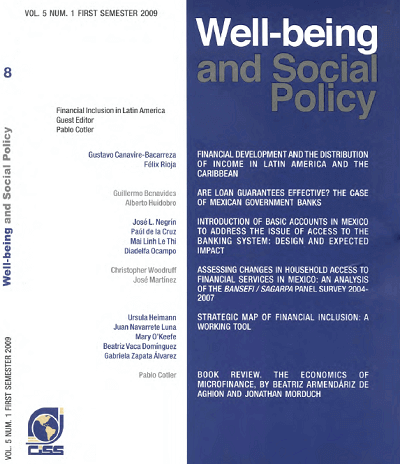
|
|
|
|

|
|
A simple poverty scorecard for Mexico
This study uses Mexico's 2008 National Household Survey of Income and Expenditure to I construct an easy-to-use scorecard that estimates the likelihood that a household has income below a given poverty line. The scorecard uses ten simple indicators that field workers can quickly collect and verify. Poverty scores can be computed on paper in the field in about five to ten minutes. The scorecard's...
|
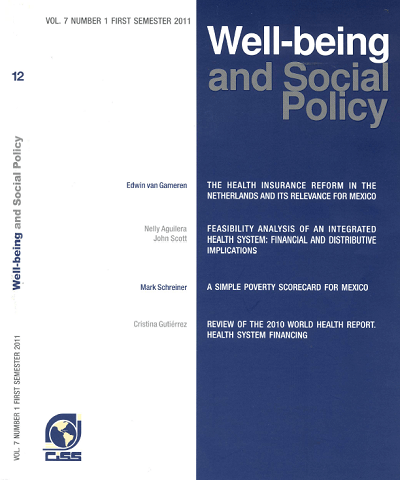
|
|
|
|

|
|
Feasibility analysis of an integrated health system: financial and distributive implications
The document presents spending projections and projections of the distributive incidence for an Integrated Health System under three basic scenarios: status quo, a two pillar scheme (financed through general taxes and private spending) and a three pillar scheme (financed through general taxes, social security contributions and private spending). By presenting these simulations, the study enhances...
|
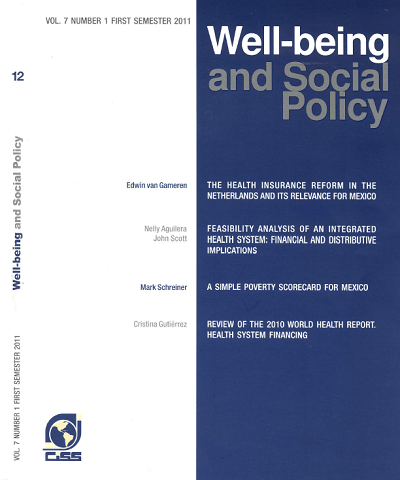
|
|
|
|

|
|
Do shocks affect poverty persistance? Evidence using welfare trajectories from Nicaragua
Shocks are often primarily associated with downward mobility or short-term movements in and out of poverty. However, households at the bottom of the welfare distribution are likely to face the most constraints to access insurance mechanisms. In this paper, we consider whether shocks directly affect poverty persistence. In order to analyze the impact of shocks on households’ welfare path over time...
|

|
|
|
|

|
|
Effect of natural disasters on poverty transitions and consumption growth. Evidence for rural Peru
Natural hazards, an increasingly important phenomenon, have a direct impact at regional and household level. The growing incidence and persistence of natural events are strongly linked to increasing vulnerability of households and communities in developing countries. Previous socioeconomic vulnerabilities may exacerbate the impact of a specific event, making more difficult the process of...
|
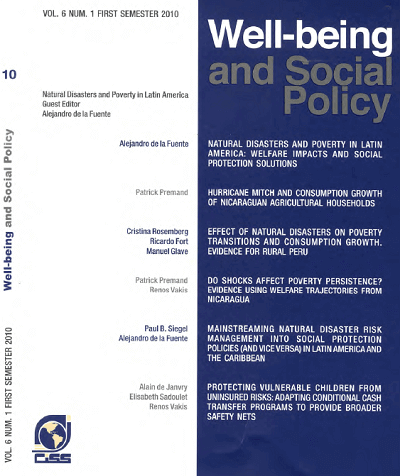
|
|
|
|

|
|
Economic polarisation and gobernality in México
The purpose of this essay is to appraise alternative hypothesis about the origins of recent social revolt in Mexico. It shows that it is not clear that a severe rise in poverty preceded the origins of violent conflict but social polarisation. Therefore, government attempts to deactivate the economic factors that led to social unrest did not necessarily upgrade povertyreduction policies. The...
|

|
|
|
|

|
|
Is age-grade distortion in Brazil's primary public education system more closely associated to school infrastructure or to family characteristics
Different economic studies have shown the importance of education in improving the quality of life of individuals. Thus, in the 90’s, the public education system was reformed to enhance the quality of public education in Brazil and motivate student interest. This paper participated in this discussion by suggesting an assessment of the impact that school infrastructure and family characteristics...
|
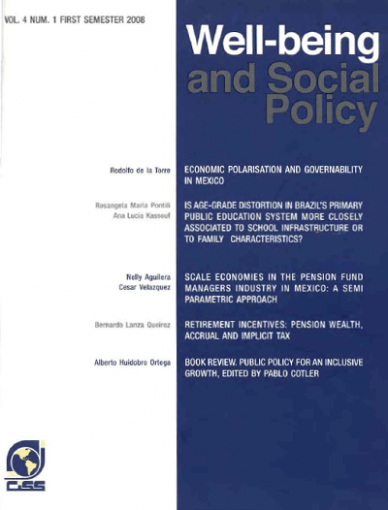
|
|
|
|

|
|
Scale economies in the pension fund managers industry in Mexico: a semi parametric approach
It has been widely accepted that reforms on pension schemes have led to improvements in the financial viability of the systems. Nevertheless, at the same time it has been shown that fees charged by pension fund managers (PFM) are very high, implying high mark-ups for them and lower expected pensions for the participants. The presence of economies of scale has been suggested as one main reason for...
|
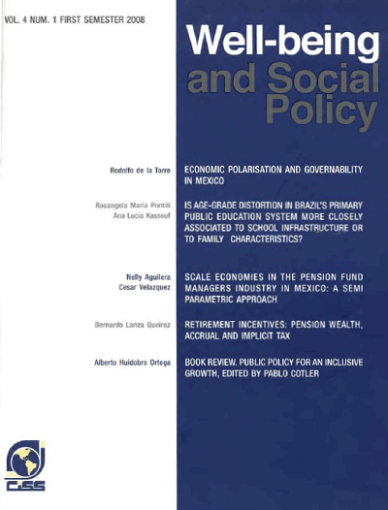
|
|
|
|

|
|
Retirement incentives: pension wealth, accrual and implicit tax
This paper estimates social security financial incentives for early retirement using contemporary techniques developed in economics, and compares these estimates to those estimated for developed countries. I find that implicit tax on continued work increases with age and amounts to over one-third of an individual potential earnings at age sixty-five. The pension replacement rate shows the degree...
|
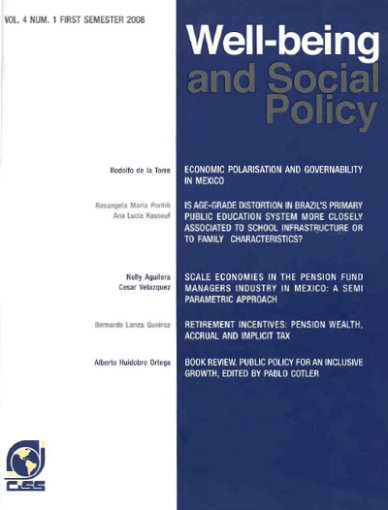
|
|
|
|

|
|
Book review. Public policy for an inclusive growth, edited by Pablo Cotler
The book “Public Policy for an Inclusive Growth” (The book) is an opportune and fortunate document. It is opportune because it is presented at a time in which public policy topics are subject to a wide debate in Mexico, and the discussion is fed with diverse points of view, theoretical and political, from which it is the purpose to analyze, design, redesign, implement, and evaluate the government...
|
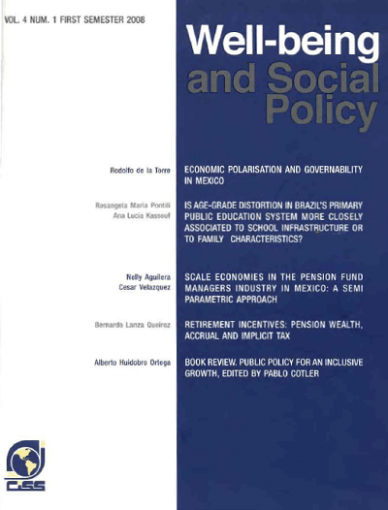
|
|
|
|

|
|
Book review. Empleo, trabajo y desigualdades en salud: una visión global. Joan Benach, Charles Muntaner, Orielle Solar, Vilma Santana y Michael Quinlan
This is a stimulating book which explores the relationship between employment conditions and health outcomes. The authors provide a conceptual framework to illustrate the channels through which health outcomes are determined and affected; this framework includes individual and aggregate variables, such as the economic, political and environmental conditions. The book also includes case studies...
|
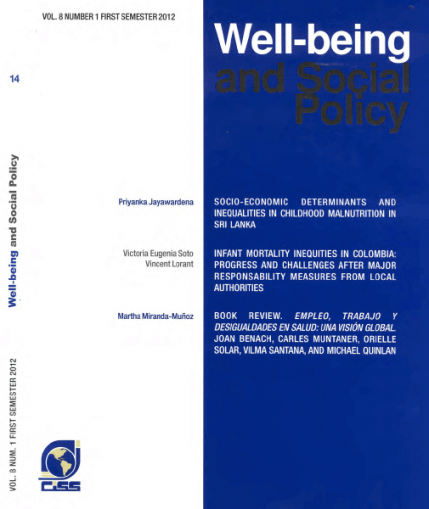
|
|
|
|

|
|
Book review. The economics of microfinance, by Beatriz Armendáriz de Aghion and Jonathan Morduch
The book by Armendáriz and Morduch focuses on how microfinance institutions work, what has been their impact and whether they are financially sustainable. For such purpose the book can be divided—from my viewpoint—into six sections. The first describes the environment of imperfect information that surrounds credit transactions and the consequences that this entails. First the authors define in a...
|
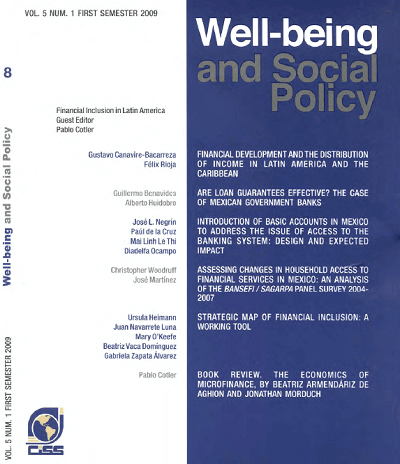
|
|
|
|
|